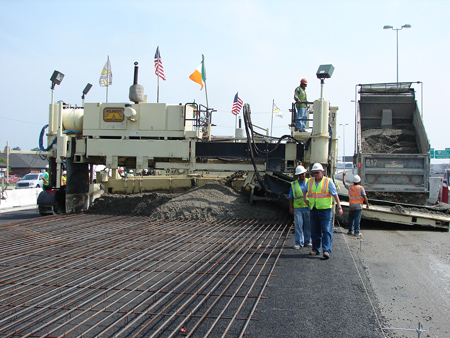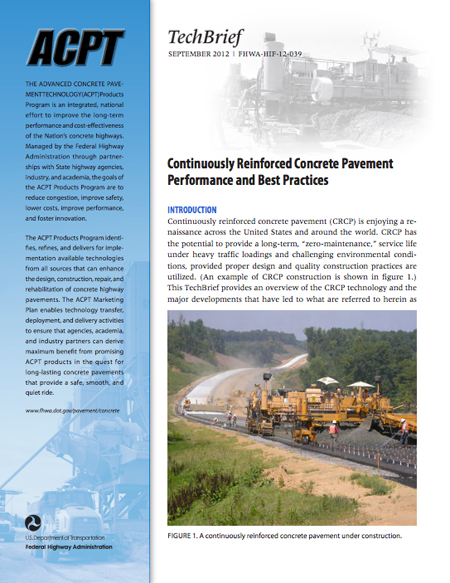U.S. Department of Transportation
Federal Highway Administration
1200 New Jersey Avenue, SE
Washington, DC 20590
202-366-4000
Focus
| Accelerating Infrastructure Innovations |
Publication Number: FHWA-HRT-13-017
Date: September 2013
Printable Version (.pdf, 0.3 mb)
A new era for concrete roadways has arrived with the use of continuously reinforced concrete pavement (CRCP) in projects across the country.
"CRCP has the potential to provide a long-term, zero-maintenance service life under heavy traffic loadings and challenging environmental conditions, provided proper design and quality construction practices are utilized," said Sam Tyson of the Federal Highway Administration (FHWA).
CRCP differs from other concrete pavements in that it has no constructed transverse contraction or expansion joints except at bridges or pavement ends. It is reinforced with continuous steel bars throughout the length of the pavement, resulting in closely spaced transverse cracks in the concrete. Rather than the usual transverse joints, these cracks accommodate volume changes in the concrete. CRCP can extend, joint free, for many miles with minimal maintenance required.
Illinois began experimenting with CRCP technology in 1947 and now has the second largest inventory of CRCP in the United States, behind Texas. California built its first experimental CRCP on U.S. 40 in 1949, followed by a second CRCP section on the roadway in 1971. The last 10 years have brought renewed interest in using the technology, leading the California Department of Transportation to adopt CRCP in its specifications and highway design manual.
CRCP use began in Texas in 1951 and continues to increase as the Texas Department of Transportation expands its roadway network and replaces jointed pavements taken out of service. Highway agencies in North Dakota, Oklahoma, Oregon, South Dakota, and Virginia have also used CRCP since the 1960s or 1970s. Their experiences have been significant in developing today's best practices for CRCP.
In 2008 FHWA entered into a 5-year Cooperative Agreement with the Concrete Reinforcing Steel Institute (CRSI) to advance the use of CRCP in the United States. Work accomplished under this agreement has resulted in updated guidance for designing and constructing CRCP.
CRCP design includes determining the proper combination of slab thickness, concrete mixture constituents and properties, and steel reinforcement content and location; providing for sufficient slab edge support; strengthening or treating existing soils; and using bases that don't erode but provide the friction that will lead to desirable transverse cracking patterns.
"While most of these features are common to all good pavement designs, reinforcement and edge support are particularly critical to CRCP," said Greg Halsted of CRSI. To learn more about CRCP design, download FHWA's Tech Brief on Continuously Reinforced Concrete Pavement Performance and Best Practices (Pub. No. FHWA-HIF-12-039) at www.fhwa.dot.gov/pavement/pub_details.cfm?id=848.
Best practices for constructing well-performing CRCP and CRCP overlays include:
During construction, it is important to focus on steel bar placement and concrete consolidation and curing. Along with the actual concrete strength, these elements will have the most significant impact on the transverse crack formation and the CRCP's long-term performance. Research and performance studies have shown that crack spacing between 0.9 and 1.8 m (3 and 6 ft) and crack widths less than 0.5 mm (0.02 in) generally result in successful CRCP performance.
A new FHWA Technical Summary and Tech Brief introduce highway pavement engineers to use of the Pavement ME Design™ software for designing CRCP. Available from the American Association of State Highway and Transportation Officials' (AASHTO) AASHTOWare® line of products, Pavement ME Design is the accompanying software to the Mechanistic-Empirical Pavement Design Guide adopted by AASHTO in 2008.
The improved design procedure resolves CRCP performance problems that had been observed in the past, including those relating to material durability, base erosion, steel placement and content, and construction methods.
The Technical Summary, Continuously Reinforced Concrete Pavement: Design Using the AASHTOWare Pavement ME Design Procedure (Pub. No. FHWA-HIF-13-025), describes the primary data inputs needed to use the Pavement ME Design software for CRCP design. Sample design problems are included that demonstrate the success of the new software in designing both CRCP and CRCP overlays for different climatic zones. For a copy of the Technical Summary, visit www.fhwa.dot.gov/pavement/pub_details.cfm?id=887. For an overview of the topic, download the Tech Brief (Pub. No. FHWA-HIF-13-027) at www.fhwa.dot.gov/pavement/pub_details.cfm?id=871.
Agencies can consult another FHWA Tech Brief, Continuously Reinforced Concrete Pavement: Improved Transition Designs (Pub. No. FHWA-HIF-13-026), to find guidance on transition designs for CRCP, including contraction, construction, and isolation joints. These designs accommodate a transition between a CRCP and any other type of pavement or structure. To download the Tech Brief, visit www.fhwa.dot.gov/pavement/pub_details.cfm?id=884.
Transportation agencies can also find guidance on rehabilitation strategies to extend the service life of an existing CRCP. Restoration techniques include full-depth repairs, partial-depth repairs, diamond grinding and grooving, joint resealing, slab stabilization and jacking, and cross stitching. Resurfacing options, meanwhile, include both bonded and unbonded concrete overlays and hot-mix asphalt overlays.
"When considering rehabilitation strategies, it must be understood that CRCP is designed to crack in the transverse direction. Such cracks are designed and expected to remain tight, and are not considered distress," said Halsted. For more information, see Continuously Reinforced Concrete Pavement: Extending Service Life of Existing Pavements (Pub. No. FHWA-HIF-13-024) at www.fhwa.dot.gov/pavement/concrete/pubs/hif13024.pdf.
Also available is Jointed Full-Depth Repair of Continuously Reinforced Concrete Pavements (Pub. No. FHWA-HIF-12-007), which describes a CRCP restoration technique that uses precast concrete panels. To obtain a copy, visit www.fhwa.dot.gov/pavement/pub_details.cfm?id=736.
FHWA and CRSI's collaboration to improve guidance for CRCP design and construction has included holding workshops in California, Georgia, Louisiana, Maryland, Oklahoma, Oregon, and Virginia, with peer-to-peer assistance also provided on request. FHWA is considering a future technology transfer initiative that would emphasize peer-to-peer assistance for project assessment, specification development, and implementation of best practice guidance for design and construction.
"While CRCP constructed in the 1960s and 1970s experienced variable performance, many miles of those pavements continue to provide satisfactory service today. CRCPs constructed since then, with improved guidance that is now the standard, promise to provide even longer maintenance-free service lives," said Tyson.
For more information on CRCP, contact Sam Tyson at FHWA, 202-366-1326 (email: sam.tyson@dot.gov), or Greg Halsted at CRSI, 360-920-5119 (email: ghalsted@crsi.org).

A typical paving operation for a CRCP. The pavement is reinforced with continuous steel bars and has minimal maintenance requirements. (Photo Credit: © VDOT)

More information about CRCP design is available in FHWA's Tech Brief on Continuously Reinforced Concrete Pavement Performance and Best Practices.